
A cruiser is a type of warship. Modern cruisers are generally the largest ships in a fleet after aircraft carriers and amphibious assault ships, and can usually perform several operational roles from search-and-destroy to ocean escort to sea denial.

The Kriegsmarine was the navy of Nazi Germany from 1935 to 1945. It superseded the Imperial German Navy of the German Empire (1871–1918) and the inter-war Reichsmarine (1919–1935) of the Weimar Republic. The Kriegsmarine was one of three official branches, along with the Heer and the Luftwaffe, of the Wehrmacht, the German armed forces from 1935 to 1945.

The Battle of the Atlantic, the longest continuous military campaign in World War II, ran from 1939 to the defeat of Nazi Germany in 1945, covering a major part of the naval history of World War II. At its core was the Allied naval blockade of Germany, announced the day after the declaration of war, and Germany's subsequent counter-blockade. The campaign peaked from mid-1940 through to the end of 1943.
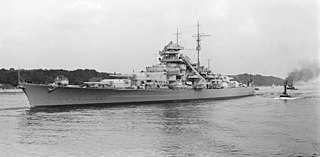
Bismarck was the first of two Bismarck-class battleships built for Nazi Germany's Kriegsmarine. Named after Chancellor Otto von Bismarck, the ship was laid down at the Blohm & Voss shipyard in Hamburg in July 1936 and launched in February 1939. Work was completed in August 1940, when she was commissioned into the German fleet. Bismarck and her sister ship Tirpitz were the largest battleships ever built by Germany, and two of the largest built by any European power.
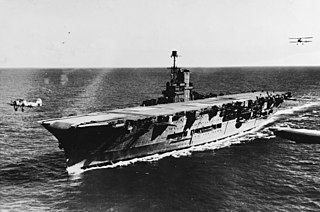
HMS Ark Royal was an aircraft carrier of the Royal Navy that was operated during the Second World War.

The Battle of Cape Matapan was a naval battle during the Second World War between the Allies, represented by the navies of the United Kingdom and Australia, and the Royal Italian navy, from 27 to 29 March 1941. Cape Matapan is on the south-western coast of the Peloponnesian Peninsula of Greece.

Force H was a British naval formation during the Second World War. It was formed in late-June 1940, to replace French naval power in the western Mediterranean removed by the French armistice with Nazi Germany. The force occupied an odd place within the naval chain of command. Normal British practice was to have naval stations and fleets around the world, whose commanders reported to the First Sea Lord via a flag officer. Force H was based at Gibraltar but there was already a flag officer at the base, Flag Officer Commanding, North Atlantic. The commanding officer of Force H did not report to this Flag Officer but directly to the First Sea Lord, Admiral of the Fleet Sir Dudley Pound.
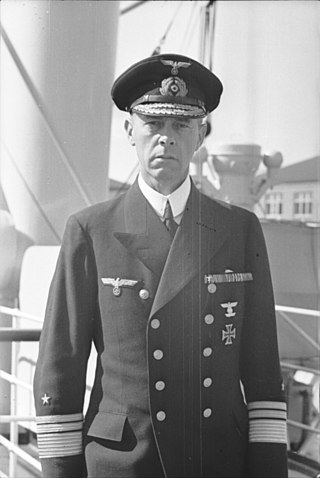
Operation Rheinübung was the last sortie into the Atlantic by the new German battleship Bismarck and heavy cruiser Prinz Eugen on 18–27 May 1941, during World War II. This operation aimed to block Allied shipping to the United Kingdom as the previously successful Operation Berlin had done. After Bismarck had sunk HMS Hood during battle of the Denmark Strait, it culminated with the sinking of Bismarck, while Prinz Eugen escaped to port in occupied France. From that point on, Germans would rely only on U-boats to wage the Battle of the Atlantic.

HMS King George V was the lead ship of the five British King George V-class battleships of the Royal Navy. Laid down in 1937 and commissioned in 1940, King George V operated during the Second World War in all three major naval theatres of war, the Atlantic, Mediterranean and Pacific, as well as part of the British Home Fleet and Pacific Fleets. In May 1941, along with HMS Rodney, King George V was involved in the hunt for and pursuit of the German battleship Bismarck, eventually inflicting severe damage which led to the German vessel's sinking. On 1 May 1942 the destroyer HMS Punjabi sank after a collision with King George V in foggy conditions. King George V took part in Operation Husky and bombarded the island of Levanzo and the port of Trapani. She also escorted part of the surrendered Italian Fleet, which included the battleships Andrea Doria and Duilio, to Malta. In 1945 King George V took part in operations against the Japanese in the Pacific.

HMS Prince of Wales was a King George V-class battleship of the Royal Navy that was built at the Cammell Laird shipyard in Birkenhead. Despite being sunk less than a year after she was commissioned, Prince of Wales had an extensive battle history, first seeing action in August 1940 while still being outfitted in her drydock when she was attacked and damaged by German aircraft. In her brief career, she was involved in several key actions of the Second World War, including the May 1941 Battle of the Denmark Strait where she scored three hits on the German battleship Bismarck, forcing Bismarck to abandon her raiding mission and head to port for repairs. Prince of Wales later escorted one of the Malta convoys in the Mediterranean, during which she was attacked by Italian aircraft. In her final action, she attempted to intercept Japanese troop convoys off the coast of Malaya as part of Force Z when she was sunk by Japanese aircraft on 10 December 1941, two days after the attack on Pearl Harbor.
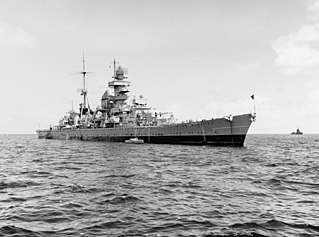
Prinz Eugen was an Admiral Hipper-class heavy cruiser, the third of a class of five vessels. She served with Nazi Germany's Kriegsmarine during World War II. The ship was laid down in April 1936, launched in August 1938, and entered service after the outbreak of war, in August 1940. She was named after Prince Eugene of Savoy, a distinguished 18th-century general in the service of the Holy Roman Empire. She was armed with a main battery of eight 20.3 cm (8 in) guns and, although nominally under the 10,000-long-ton (10,160 t) limit set by the Anglo-German Naval Agreement, actually displaced over 16,000 long tons (16,257 t).

The Battle of the Denmark Strait was a naval engagement in the Second World War, which took place on 24 May 1941 between ships of the Royal Navy and the Kriegsmarine. The British battleship HMS Prince of Wales and the battlecruiser HMS Hood fought the German battleship Bismarck and the heavy cruiser Prinz Eugen, which were attempting to break out into the North Atlantic to attack Allied merchant shipping through the Denmark Strait between Greenland and Iceland.

Sink the Bismarck! is a 1960 black-and-white CinemaScope British war film based on the 1959 book The Last Nine Days of the Bismarck by C. S. Forester. It stars Kenneth More and Dana Wynter and was directed by Lewis Gilbert. To date, it is the only film made that deals directly with the operations, chase and sinking of the battleship Bismarck by the Royal Navy during the Second World War. Although war films were common in the 1960s, Sink the Bismarck! was seen as something of an anomaly, with much of its time devoted to the "unsung back-room planners as much as on the combatants themselves". Its historical accuracy, in particular, met with much praise despite a number of inconsistencies.

Strasbourg was the second and final member of the Dunkerque class of fast battleships built for the French Navy in the 1930s. She and her sister ship Dunkerque were designed to defeat the German Deutschland class of heavy cruisers that had been laid down beginning in the late 1920s, and as such were equipped with a battery of eight 330 mm (13 in) guns to counter the six 280 mm (11 in) guns of the Deutschlands. Strasbourg was laid down in November 1934, was launched in December 1936, and was commissioned in September 1938 as the international situation in Europe was steadily deteriorating due to Nazi Germany's increasingly aggressive behavior.

Operation Berlin was a raid conducted by the two German Scharnhorst-class battleships against Allied shipping in the North Atlantic between 22 January and 22 March 1941. It formed part of the Battle of the Atlantic during World War II. The Scharnhorst and Gneisenau sailed from Germany, operated across the North Atlantic, sank or captured 22 Allied merchant vessels, and finished their mission by docking in occupied France. The British military sought to locate and attack the German battleships, but failed to damage them.

Operation Sportpalast, also known as Operation Nordmeer, was a German naval raid between 6 and 13 March 1942 against two of the Allied Arctic convoys of World War II as they passed through the Norwegian Sea. It was conducted by the battleship Tirpitz, three destroyers and eight submarines. The German ships were unable to locate either of the convoys but sank a merchant vessel that was sailing independently. The Allies attempted to intercept the German force, also without success.
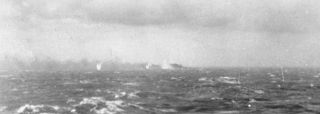
The last battle of the German battleship Bismarck took place in the Atlantic Ocean approximately 300 nautical miles west of Brest, France, on 26–27 May 1941 between the German battleship Bismarck and naval and air elements of the British Royal Navy. Although it was a decisive action between capital ships, it has no generally accepted name. It was the culmination of Operation Rheinübung where the attempt of two German ships to disrupt the Atlantic Convoys to the United Kingdom failed with the scuttling of the Bismarck.

World War II saw the end of the battleship as the dominant force in the world's navies. At the outbreak of the war, large fleets of battleships—many inherited from the dreadnought era decades before—were one of the decisive forces in naval thinking. By the end of the war, battleship construction was all but halted, and almost every remaining battleship was retired or scrapped within a few years of its end.

The Bismarck class was a pair of fast battleships built for Nazi Germany's Kriegsmarine shortly before the outbreak of World War II. The ships were the largest and most powerful warships built for the Kriegsmarine; displacing more than 41,000 metric tons normally, they were armed with a battery of eight 38 cm (15 in) guns and were capable of a top speed of 30 knots. Bismarck was laid down in July 1936 and completed in September 1940, while her sister Tirpitz's keel was laid in October 1936 and work finished in February 1941. The ships were ordered in response to the French Richelieu-class battleships. They were designed with the traditional role of engaging enemy battleships in home waters in mind, though the German naval command envisioned employing the ships as long-range commerce raiders against British shipping in the Atlantic Ocean. As such, their design represented strategic confusion that dominated German naval construction in the 1930s.


















